01: Hook Points
Between The Lines - Ch05: Rigging
|
The first material is chemically-sharpened high carbon steel. It is quite useless when applied for trolling hooks as the hooks are designed to be sharpened by use of an electrical current. When hooks travel through the water and over the earth's magnetic field an electrical current is generated that continually eats at the hook, including the point. This will result in the point literally falling off, often within a very short period of time. To use these kinds of hooks, a waterproof coating must be applied to protect the hook from the electrical current. That said, coating these hooks is worth the effort and expense, as many in this group are the best available for light tackle trolling. The second category is steel hooks with various plating such as zinc and cadmium. They are cheap and easy to sharpen, but hard to maintain as sharpening exposes the steel to corrosion, resulting in rust. There are many ways of reducing corrosion such as coating the points with grease, felt tip pen ink and the like. The greatest advantage is that these hooks are the strongest, and the greatest disadvantage is the high maintenance. The final category is stainless steel. Stainless hooks are the easiest to sharpen and maintain, and although the most expensive, are the preferred choice for most trolling rigs. It is open to debate as to which hook material is best for the fish's mortality. Chemically-sharpened hooks will corrode the quickest, but the electrical charge it generates may well interfere with the fish finding and capturing food. Steel hooks and their coating may eventually result in the fish dying of blood poisoning. Stainless does not cause poisoning, nor will it corrode. What is important in hook choice is to ensure the hook does not interfere too much with the fish feeding. Most hooks used in lure rigs fall out quickly once there is no pressure from the line. The factors involved in getting a hook into and through a jaw is the level of pressure applied to a hook point to get it to penetrate. Thus, line class and drag setting are an integral part of how much force is applied to the point. Hook thickness (Fig 2) is an aspect of this. Logically, the thinner the hook the easier it is for it to penetrate. Depending on the material, the thinner the hook the lighter it is, so the lure action will be less restricted. Again, depending on the material of the hook, the thinner it is, the weaker the hook and the more likely it is to flex and bend under pressure. Of course, this only becomes a concern if you do hook up and certainly finer hooks will give up the fight more often. When using light and ultra-light tackle, thinner gauge hooks are preferable for a good hook-up rate but may flex and bend under excessive load, so often the fish must be tagged or gaffed off the rod tip, or only light pressure is applied to the leader to bring the fish to the boat. Essentially two gauges of hook thickness will cover most situations. Rather than specify line class we'll specify drag settings as this is a more accurate guide. On drag settings less than eight kilograms, fine wire hooks can be used. Any drag set over eight kilos and the standard hook gauge will do the job.
Straight point hooks are often used as they have maximum gape for deeper penetration, but due to their shape, are best used in stiff rigs which The actual point and barb of the hook is critical in length, angle and shape. Within a short time from now, this will not be a consideration as new, very sharp hooks with correct barbs will be available straight out of the box. Even now most of the hooks we use on light drags are chemically sharpened. At this point in time, however, most hooks used on medium and heavy drag settings still need an element of surgery to get the best out of them. Preparing a hook point involves shaping the point initially with a coarse cut with either a grinder or file. Using a grinder takes a great deal of experience to get the angles right without overheating the hook and destroying the temper of the metal. Using a file is much easier for a beginner.
The other main type of point is the blade, which has cutting edges on the barb and top of the point. The longer and finer the point the easier it is to penetrate, however, too fine a point will fold under pressure. Often to increase strength a slight angle is put on the tip of the point. With a bit of experience sharpening a hook using a file called a "Flat Bustard Second Cut" can be done quite quickly and can result in a well-cut point. (Vid 1) If a vice is used to hold the hook while sharpening, rubber or wooden blocks should be used to hold the hook, as metal jaws may crack and weaken the metal of the hook. Note that for heavier line classes the end of the point is angled to strengthen it. (Fig 7) The hook point can then be polished with finer cut files and hones. Although finishing is often left until after the hooks are rigged as they can be damaged.
The minimum hook size is determined by the size of the lure head. The hook gape should be able to fit around the lure head. (Fig 8) This idea is based on allowing at least half of the gape of the hook free to penetrate deeply into a fish's jaw. (Fig 9)
However, with the lighter gauge hooks, you can use larger hook sizes without affecting lure action to a great extent. Disproportionately large hooks are often necessary for tiny lures such as the Uzi, as rather large fish readily strike them. The larger hook size is needed to get around the large jaw bones for a successful hook-up rate. (Fig 11) The best way to ensure you've made acceptable choices regarding tackle of all forms, including hook size, shape and point is to test it. (Vid 2) Note the video only shows a test on a certain way of sharpening heavy-tackle hooks. We have found that the fine-gauge hooks set at 2.5 kilos, and our medium hooks set at four kilos. It really is up to you to test your own tackle. It is regretful the marlin died during its fight. Had the angler and crew more knowledge as contained within these pages it is more likely the outcome would have been a tagged fish set free in good condition.
|






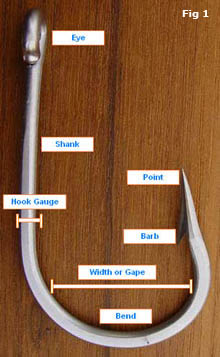 At the time of writing, no manufacturer had as yet released a dedicated hook for use in skirted trolling lures. We must do our best with what is readily available for the task. Put simply, this task is to get a hook point through an often very tough jaw, so that the hook holds on the bend (Fig 1) and not just on the point and barb.
At the time of writing, no manufacturer had as yet released a dedicated hook for use in skirted trolling lures. We must do our best with what is readily available for the task. Put simply, this task is to get a hook point through an often very tough jaw, so that the hook holds on the bend (Fig 1) and not just on the point and barb. 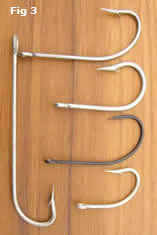 Hook length (Fig 3) and the overall shape of the hook is another consideration. Essentially, the longer the shank, the more stable the hook is, and the easier it is to set. The instability that may be caused by shorter hook shanks can be overcome by turning the point in so that it faces the eye of the hook. The result is the force applied to the eye of the hook is directly in line with the point. In fact, regardless of hook length, the more the point of the hook is in line with the eye of the hook, the easier it is to set the hook.
Hook length (Fig 3) and the overall shape of the hook is another consideration. Essentially, the longer the shank, the more stable the hook is, and the easier it is to set. The instability that may be caused by shorter hook shanks can be overcome by turning the point in so that it faces the eye of the hook. The result is the force applied to the eye of the hook is directly in line with the point. In fact, regardless of hook length, the more the point of the hook is in line with the eye of the hook, the easier it is to set the hook.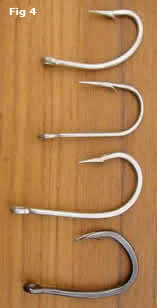 The restriction here is in many cases if you were to have a hook of this shape, the gape of the hook would be too small to go around the fish's jawbone without using a very large hook. Even though there are a great many types (fig 4) of points offered in hooks that may be used for trolling, we still end up with the compromise of using hooks with points that are turned in slightly. Fig 5)
The restriction here is in many cases if you were to have a hook of this shape, the gape of the hook would be too small to go around the fish's jawbone without using a very large hook. Even though there are a great many types (fig 4) of points offered in hooks that may be used for trolling, we still end up with the compromise of using hooks with points that are turned in slightly. Fig 5)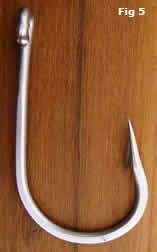 effectively lengthen the shank. This results in the pull coming to a distance away from the point which helps in getting this shape hook to penetrate. Unfortunately, the stiff rigs do restrict lures that are designed to have any type of head-shaking action such as all Pakula Lures.
effectively lengthen the shank. This results in the pull coming to a distance away from the point which helps in getting this shape hook to penetrate. Unfortunately, the stiff rigs do restrict lures that are designed to have any type of head-shaking action such as all Pakula Lures.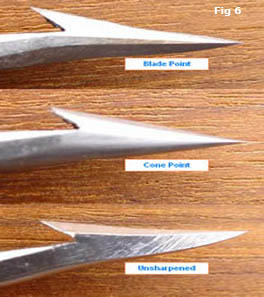 The desired shape is a fine barb with a tapered point. There are two main types of point. (Fig 6) The cone point is certainly the stronger, but it does take longer to sharpen each hook. Unfortunately once the hook point is damaged resharpening results in a shorter thicker point that is harder to set than a finer point.
The desired shape is a fine barb with a tapered point. There are two main types of point. (Fig 6) The cone point is certainly the stronger, but it does take longer to sharpen each hook. Unfortunately once the hook point is damaged resharpening results in a shorter thicker point that is harder to set than a finer point.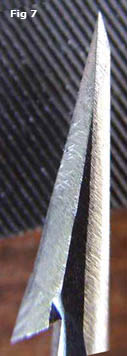
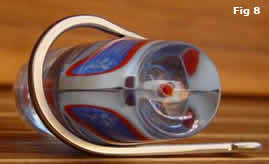
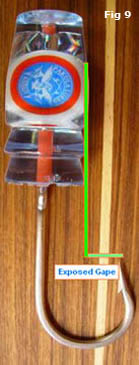 Once again there needs to be a compromise, as the smaller, the hook the less inhibited (Fig 10) the lure action, the larger the hook the fewer shots you get.
Once again there needs to be a compromise, as the smaller, the hook the less inhibited (Fig 10) the lure action, the larger the hook the fewer shots you get.
